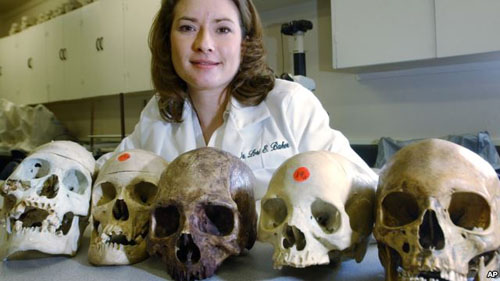VOA慢速英语:确认墨美边境无名死者的名字
From January to September of this year an estimated230 migrants died trying to cross the border fromMexico into the United States. This is according to anew report released by the International Organizationfor Migration. The organization says that number mightbe higher.
The exact number of victims is not known. Their namesare also not known.
But a university professor in Texas is trying to give closure to families who have lost relatives on the border.
Holding a human rib bone in her gloved hand, BaylorUniversity Anthropology Professor Lori Baker notessigns of postmortem damage -- damage done after death.
“This would be indicative of vulture damage.”
The bone is part of a skeleton, a set of bones. It was found in the lower RioGrande River valley of Texas, close to the Mexican border. People dying in the desert, their remains being eaten by scavenger birds such as vultures, are realities of Ms. Baker’s work.
 |
|
Dr. Lori Baker, a forensic scientist at Baylor University, seen here in this Aug. 29, 2003 file photo, launched a project to try to match unidentified remains found along the border. |
The U.S. Department of Homeland Security estimates that more than 6,000immigrants have died crossing into the United States from Mexico in the past15 years.
Local officials have found hundreds of unidentified bodies in south Texas alone. They have buried them in mass graves in local cemeteries.
Families have no bodies to bury, no graves to visit. To help them get closure, Professor Baker and her students have been digging up bodies to try to identify them.
Lori Baker says that in most cases, the people died of the heat.
“There are a few traumatic things we need to look at, but, all in all, most of theindividuals that we see die of heat exhaustion.”
She says that smugglers often leave immigrants in unpopulated areas where there is no water or shelter. Ms. Baker says that it is hard to know how many have died.
“So there are probably a lot more individuals who have died and just have not been found.”
Families in Mexico and Central America have spent many years looking forlost loved ones. Often, officials say, immigrants carry no identification. If they die, they are gone without leaving a trace.
Student volunteers help the cause
Ms. Baker understands the problems local officials face in rural U.S. counties.They have little money. A coalition of Texas sheriffs-- law officers --says eachdead migrant they find costs a county $5,000 to remove, examine and bury.
A team of student volunteers helps Professor Baker. The volunteers take part in the hard, sad work of digging up bodies for the forensics. But they say theyalso share Prof. Baker’s sense of mission.
The work can be not only physically hard. It can be emotionally hard as well.
Jennifer Husak is a recent Baylor graduate. She spent two summers workingwith Lori Baker in south Texas. She remembers that the most difficult time in this work came early on, when she examined the bones of a baby. Ms.Husak says it was hard for her to think about the work. At that moment, thebones had a family story connected to them.
“It was very difficult for me at first to think about a mother not being able towatch her child grow up. It was very difficult.”
Chelsea Art is studying anthropology at Baylor University. She worked withLori Baker at a cemetery about 100 kilometers north of the border. Hundredsof bodies have been found there over the years. Not many people live in thearea. Immigrants are often extremely tired and in great need of water by thetime they arrive.
Ms. Art says working in the heat gave her some idea, however small, of howterrible it must be for an immigrant to be out in the open without any support.
Personal mission
It has also become personal for Lori Baker. She says she hopes to givehuman respect, or dignity, to those who have died trying to cross the border.
“I hope that through the work we do we will be able to restore some human dignity to that person by giving them a name.”
Ms. Baker and her volunteers have worked with more than 170 bodies andhave identified three. She has spoken to family members of these people andknows firsthand how much it means to them.
The final goal for Lori Baker is to return identified remains to their families.Then at least they can have a burial place where they can say prayers andleave flowers.
I’m Anna Matteo.
VOA’s Greg Flakus reported this story from Texas. Anna Matteo wrote it forLearning English.
______________________________________________________________
Words in this Story
scavenger n. an organism (as a vulture or hyena) that usually feeds on deador decaying matter
cemetery n. a place where dead people are buried
closure n. a feeling that a bad experience (such as a divorce or the death of a family member) has ended and that you can start to live again in a calm and normal way
smuggle v. to move (someone or something) from one country into another illegally and secretly. A smuggler is someone who smuggles.
forensic adj. relating to the use of scientific knowledge or methods in solving crimes
dignity n. the quality of being worthy of honor or respect
mission n. a task that you consider to be a very important duty
trace n. a sign or evidence of some past thing
- 频道推荐
- |
- 全站推荐
- 推荐下载
- 网站推荐




















